From pv magazine 11/2020
On Aug. 9th 2019, vast swathes of southern England were witness to an event that sounds somewhat abstract. Sudden loss of power supply cascaded through the grid, taking other generators down with it. A lightning strike at a gas-fired power plant in the Bedfordshire village of Little Barford caused an outage at the generator, and the frequency in the grid fell at a rate of 0.144Hz per second – also called the rate of change of frequency (RoCoF).
If RoCoF exceeds a certain threshold or the frequency dips below a certain point, other power generation equipment in the grid trips, preventing damage to the generators. This protective tripping took place at the nearby Hornsea 1 offshore wind farm, 45 seconds after the lightning strike. The result was a power shortfall of 1.5 GW, leaving over a million households, hospitals, and critical traffic infrastructure in the dark.
Thermal power stations have an inherent protection mechanism against sudden supply losses – the massive rotor of the synchronous generator spinning at 50 times a second. Due to the inertia, it will not suddenly stop. Instead, before the lights go out, the rotor gradually loses speed, maintaining RoCoF within required margins.
For most generators, inertia is about 7-15% of the nameplate generation capacity. It yields something between 10 and 60 seconds to the grid operator to mitigate the disturbance – referred to as “governor action.” But the less spinning mass there is left, the more sensitive a grid becomes to slight disturbances. An event such as the Aug. 9 incident in England could occur from a power gap much smaller than the 1.5 GW experienced on that day.
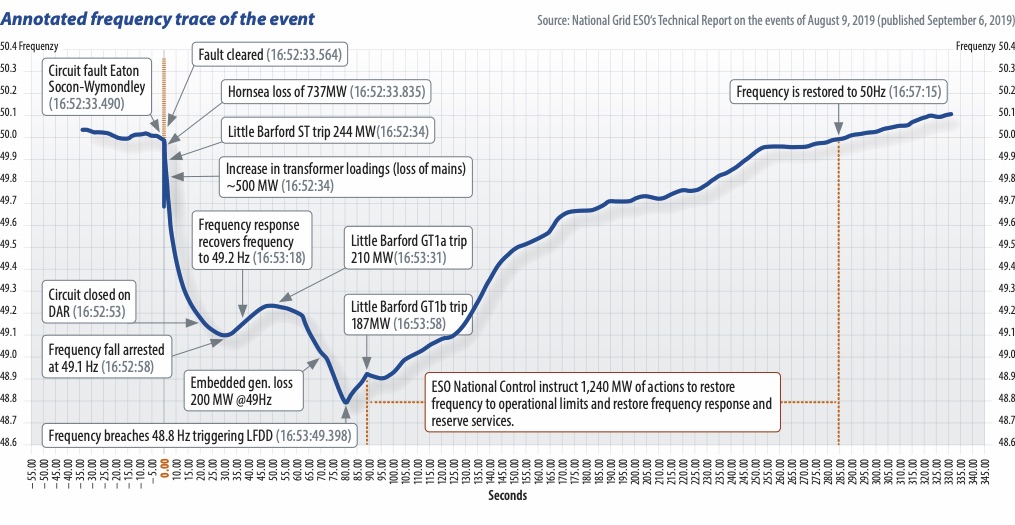
“The lower the inertia in an electricity system […], the higher the RoCoF, because there is no inertia to counterbalance the loss of supply,” says Marek Kubik, market director EMEA at Fluence, an energy storage and grid service company. “For example, there is a loss of power because a tree has fallen onto a power line, and that causes one power station to trip, and then that causes another one to trip and another one to trip […] This challenge of inertia is really one of the main ones you have in moving toward a renewable energy power system.”
As increasingly more synchronous generators are decommissioned and replaced with power electronics-interfaced forms of generation from primarily wind and solar, the amount of energy stored in spinning rotors decreases proportionally in the grid. The electrical properties of thermal generators, such as providing inertia and setting the grid frequency, must be emulated by power electronics – a big task for grid operators and a rather ample opportunity for a new set of technologies.
Grid migration
Dutch-German transmission system operator (TSO) Tennet led a four-year, pan-European research project that brought together 10 other TSOs, 12 research institutes, and one industry partner under the Massive Integration of Power Electronic Devices (Migrate) project, funded under the EU’s Horizon 2020 framework. The project’s core quest was to determine how large the share of power electronics-interfaced generation could be, under current or just slightly improved control mechanisms, and under what conditions an entirely power electronics-interfaced generation fleet would need to operate.
“What we learned is that we need an interplay of grid-forming and grid-following controls,” explains Hannes Munzel, project coordinator of Migrate and program manager offshore chain at TSO Tennet. “We need a conductor in the grid, something that sets the rhythm, and we need those who follow the tune.” According to Munzel, a power grid based entirely around power-electronics-interfaced generation units requires around 30% grid-forming inverters.
To come to this conclusion, the project partners examined relatively isolated grids with a high degree of renewables, such as Ireland and Iceland. The Irish grid is currently comprised of 40% renewable energy generation, on average. That means, on some days, Ireland is powered almost entirely by renewables. This is also achieved in Denmark and Germany occasionally, but while these two markets feature significant AC interconnector capacity to their neighbors, helping to mitigate frequency imbalances, the Irish grid only has DC links to the rest of Britain. That makes Ireland, in terms of frequency and inertia, more like a microgrid.
“Because we examined how the grid reacts to high levels of power electronics on a small-scale level, we can draw some conclusions which apply to the large-scale continental grid,” says Munzel. And among those learnings is that inertia is not a total system function but is more robust in regions with synchronous machines and becomes weaker over longer transmission corridors, leading to serious angle stability issues. Using tools like phasor measurement units (PMU), which measure voltage, current, frequency, and phase angle, the team developed the concept of Effective Area Inertia – which captures the relationship of power imbalance and RoCoF in a limited area.
First come, first served
For grid operators to accurately measure Effective Area Inertia and respond accordingly, a step-change in reaction times and measurement resolution is necessary. The Migrate project partners have launched a wide-area monitoring, protection, and control (WAMPAC) pilot on the Icelandic grid.
“At the moment, we are continuing the development of WAMPAC grid control systems and work with PMUs to develop a neural network to provide the control mechanisms necessary to stabilize a power electronics dominated grid,” says Tennet’s Munzel. “These technologies are the most promising for us at the moment, but it will take more efforts to develop.” One issue Munzel points to is standardizing communication protocols and technologies across European TSOs. For Tennet, the solution to the challenges posed by a power electronics dominated grid must be found on the European level, mirroring the European grid itself.
In Iceland, WAMPAC can already identify the area in which a disturbance occurs thanks to a network of PMUs which have been set up in the grid. Once the system locates a disturbance, it estimates inertia and RoCoF in the area and triggers a response. The system will then ramp-up or down hydro capacity and step-up or down industrial loads from smelters and other facilities. WAMPAC managed to deliver responses in less than 0.5 seconds in the pilot – a decisive feature for inertia emulation.
Real time
Because inertia in a synchronous generator is instantaneous, response time is an essential factor for any replacement. Frequency response products in many markets have been around for quite some time and are designed to fit thermal generators’ capabilities. In the U.K., for example, National Grid’s fastest product, called firm frequency response (FFR), demands a response within 10 seconds of the frequency falling. In Germany, the infrastructure regulator Bundesnetzagentur demands of the FFR-equivalent, Primärregelleistung, a response time of 30 seconds. It is expected that inertia covers the time in between, but with that option now becoming a thing of the past, grid operators need to revise the list of products they need to procure.
National Grid has just updated its requirements for network stability improvement in Scotland under its stability pathfinder program. The national electricity system operator procures stability on a technology-agnostic level in Scotland, with the additional requirement to provide 6 GW-seconds of inertia. The organization said that it had only just extended the procurement exercise for inertia response. Previously, the stability assets’ technical requirement was just on short circuit level capacity and dynamic voltage support. Part of the program, National Grid writes, is to reiterate these stability services’ procurements on an annual basis to achieve a ‘closer-to-real-time’ inertia market.
Indeed, the ability to react like a streak of lighting means that grid-forming inverters can enter into competition with synchronous condensers. Synchronous condensers are synchronous motors that adjust grid voltage to generate or absorb reactive power. The disturbances that inertia slows down stem from an imbalance between active power and reactive power. Synchronous condensers cannot do anything else, however, so fast operated grid-forming power electronics could step in and stack a whole range of other value streams on top, according to the Migrate project findings.
Currently, grid-forming inverters aren’t installed on a broad scale, and they are mostly deployed in microgrids, where black start capability is required. “And we are only just on the cusp of the this,” says Kubik. “If there are specific services which are going to be rewarded, that a grid-forming inverter can provide and a grid-following inverter cannot. That can be things like virtual synchronous machine (VSM) capability, and some system operators are starting to look at this now.”
New products
The Fluence engineer continues to argue that grid-following inverters have successfully pushed the limits of its technology to provide supporting functions. Providing FFR in less than a blink of an eye lowers the Nadir, which indirectly helps to keep RoCof where it should be. VSM capable devices, meanwhile, affect RoCof directly by acting as a voltage source.
In Ireland, Fluence, together with independent power producer Statkraft, has set up an 11 MW battery storage system, providing very fast, inertia-like response and other ancillary services in 150ms. With Ireland poised to integrate as much as 70% renewables by 2030, the grid operator EirGrid has opened the market to provide inertia from any technology.
“What we are seeing now is both National Grid in the UK and EirGrid in Ireland have recognized in a different way that speed matters,” Kubik says. “In the UK case, they are introducing a faster responding product [less than the 10s FFR] that is more demanding and batteries are very well set up to provide it – less assets can provide this because it is more challenging. And they are specifically procuring faster-responding technologies as a future proving measure for the requirements further down the line.”
Meanwhile, Ireland has introduced with its DS3 auctions hyperfast products with required response times of less than two seconds. Moreover, the grid operator pays a price on performance. Fluence’s battery responds within 150ms of the frequency falling. Because it reacts so fast, the battery pushes power into the grid before the frequency reaches the Nadir – the lowest frequency during a disturbance – thus reducing the RoCoF.
“So, if a battery or another technology is providing these frequency services in two seconds, it gets paid a certain amount of money,” explains Kubik. “But if it responds in 150ms, it gets paid three times as much. So, there is a quantitative recognition that it is three times more valuable to respond very quickly than it is to respond slightly more slowly.”
This doesn’t mean that power electronics emulated inertia is more expensive to end customers, however. Irish grid operators also procure the product Synchronous Inertial Response (SIR), which reimburses thermal generators for leaving some overhead capacity to react in case of a frequency event. Additionally, there needs to be a minimum of seven conventional generators running at all times, irrespective of renewables penetration, to maintain sufficient inertia levels.
A team of researchers from Queens University Belfast and storage and renewables consultancy Everoze looked at the cost of battery storage and synthetic inertia. According to the research, stacking several value streams, such as providing FFR on top of inertial response, would lead to annual savings of €19 million in system services cost – around 10% of the €169 million to €220 million that are expected to be paid under the DS3 stability program this year.
This content is protected by copyright and may not be reused. If you want to cooperate with us and would like to reuse some of our content, please contact: editors@pv-magazine.com.
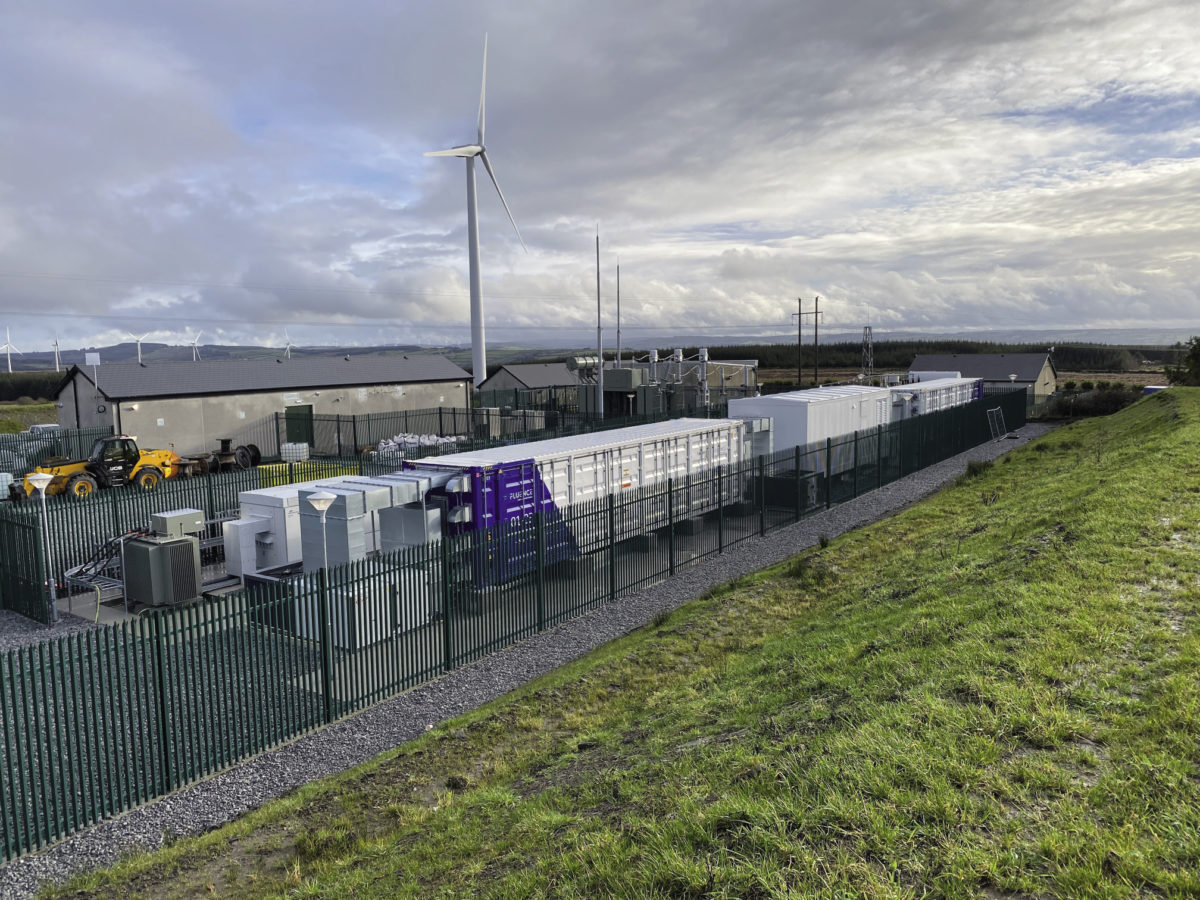
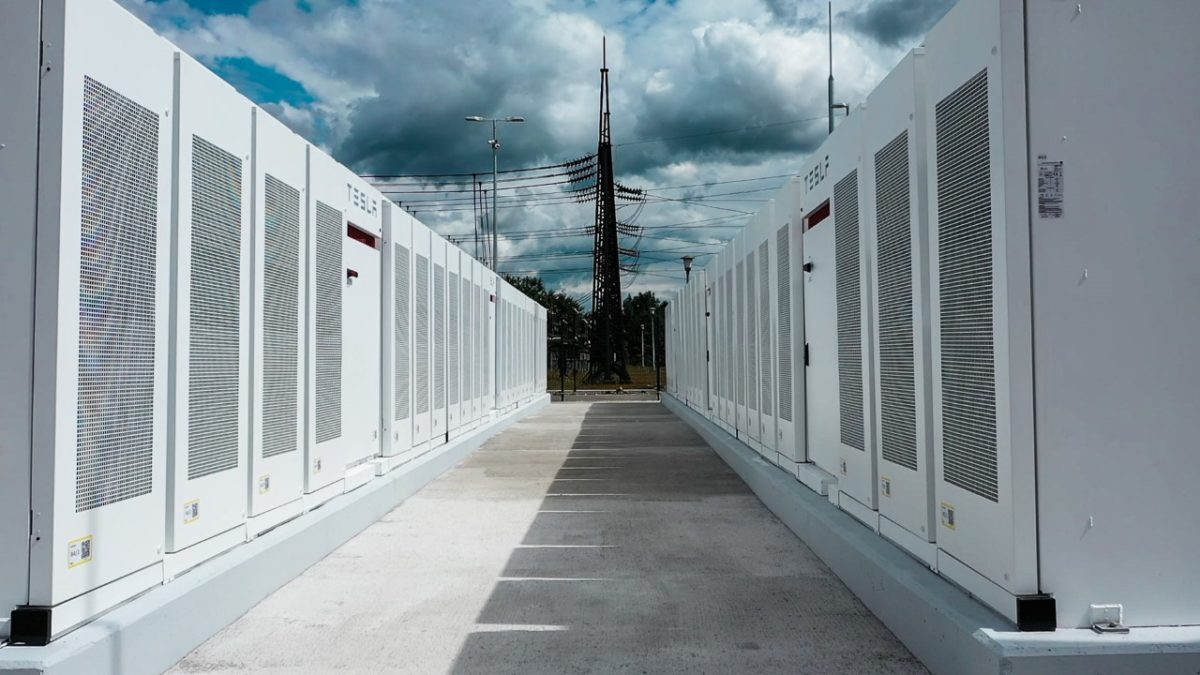

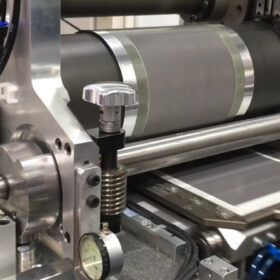
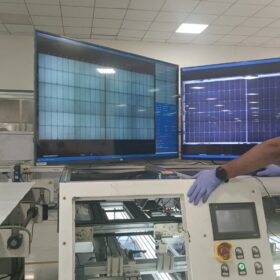
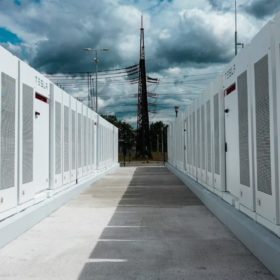
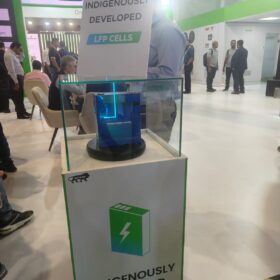
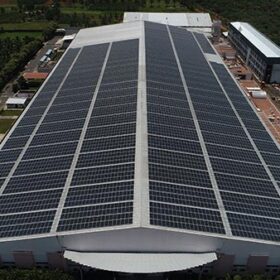
Inertia does not actually provide 30 seconds of energy in the German grid. Inertia of a few hundred generators and millions of rotating loads + the capacitance of transmission assets provides enough energy to compensate for the loss of 1-5 % of generation capacity for 30 seconds.
Solar and wind farm inverters can be set to run at 90-95% of instantaneously available power and wind turbines can contribute rotational inertia so that combined they can provide even faster response than the inertia of a turbine. It is true that in the first 10 msecs rotating inertia will respond a little bit faster but by 200 msecs the inverter/synthetic inertia/battery response will be much larger.
A gas turbine usually has inertia of around 3 MWseconds per MW, a steam turbine 9 MWs/MW. If the frequency changes by 0.15 Hz/s the inertia changes by 1-((50-.15)/50)^2 = .006 after 1 second. Thus a 100 MW gas turbine contributes 0.006 x 3 x 100 = 1.8 MWs in the first second. An inverter that takes 150 ms to respond will provide an average of half capacity for say 250 ms and 100% of capacity for 750 ms. So after one second it has provided .875 x nominal capacity. so to provide the same level of stabilisation for 1 second that a 100 MW gas turbine provides the inverter would need to be rated at 1.8/.875 = 2 MW.
Obviously if the rate of change of frequency was higher, the inverter needs to provide more power. If response was measured over a shorter time, say 0.25 seconds, then the inverter would need to be bigger but even with a ROCF of 0.5 Hz/s to provide the same amount of energy as the inertia of a 100MW gas turbine in 250 ms the inverter would need to be rated at 12 MW . Thus a 120 MW solar farm which was currently producing 100 MW DC but limited output to 88 MW could provide the same “synthetic inertia” as a 100 MW gas turbine.